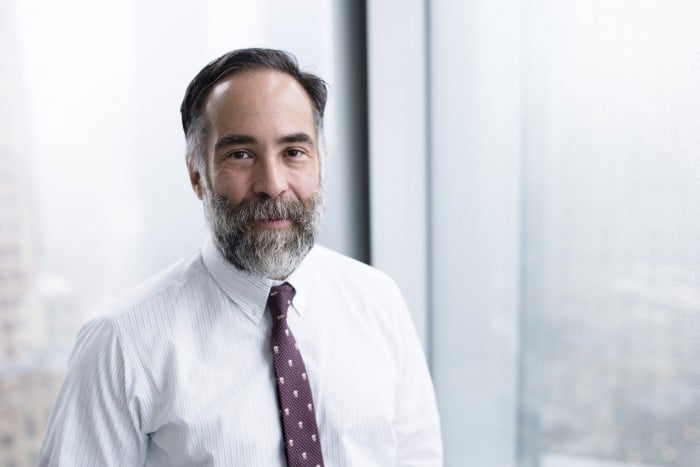As Goldman Embraces Automation, Even the Masters of the Universe Are Threatened

At its height back in 2000, the U.S. cash equities trading desk at Goldman Sachs’s New York headquarters employed 600 traders, buying and selling stock on the orders of the investment bank’s large clients. Today there are just two equity traders left.
Automated trading programs have taken over the rest of the work, supported by 200 computer engineers. Marty Chavez, the company’s deputy chief financial officer and former chief information officer, explained all this to attendees at a symposium on computing’s impact on economic activity held by Harvard’s Institute for Applied Computational Science last month.
The experience of its New York traders is just one early example of a transformation of Goldman Sachs, and increasingly other Wall Street firms, that began with the rise in computerized trading, but has accelerated over the past five years, moving into more fields of finance that humans once dominated. Chavez, who will become chief financial officer in April, says areas of trading like currencies and even parts of business lines like investment banking are moving in the same automated direction that equities have already traveled.
Today, nearly 45 percent of the revenue from cash equities trading comes from electronic trades, according to Coalition, a U.K. research firm that tracks the industry. In addition to back-office clerical workers, on Wall Street machines are replacing a lot of highly paid people, too.
Average compensation for staff in equities sales, trading, and research at the 12 largest global investment banks, of which Goldman is one, is $500,000 in salary and bonus, according to Coalition. Seventy-five percent of Wall Street compensation goes to these highly paid “front office” employees, says Amrit Shahani, head of research at Coalition.
For the highly paid who remain, there is a growing income spread that mirrors the broader economy, says Babson College professor Tom Davenport. “The pay of the average managing director at Goldman will probably get even bigger, as there are fewer lower-level people to share the profits with,” he says.
Complex trading algorithms, some with machine-learning capabilities, first replaced trades where the price of what’s being sold was easy to determine on the market, including the stocks traded by Goldman’s old 600.
Now more complex areas of trading like currencies and credit, which are not traded on a stock exchange like the New York Stock Exchange but rather through less-transparent networks of traders, are coming in for more automation as well. To execute these trades, algorithms are being designed to emulate as closely as possible what a human trader would do, explains Coalition’s Shahani.
Goldman Sachs has already begun to automate currency trading, and has found consistently that four traders can be replaced by one computer engineer, Chavez said at the Harvard conference. Some 9,000 people, about one-third of Goldman’s staff, are computer engineers.
Next, Chavez said, will be the automation of investment banking tasks, work that traditionally has been focused on human skills like salesmanship and building relationships. Though those “rainmakers” won’t be replaced entirely, Goldman has already mapped 146 distinct steps taken in any initial public offering of stock, and many are “begging to be automated,” he said.
Reducing the number of investment bankers would be a great cost savings for the firm. Investment bankers working on corporate mergers and acquisitions at large banks like Goldman make on average $700,000 a year, according to Coalition, and in a good year they can earn far more.
Chavez himself is an example of the rising role of technology at Goldman Sachs. It’s his expertise in risk that makes him suited to the task of CFO, a role more typically held by accountants, Chavez told analysts on a recent Goldman Sachs earnings call.
“Everything we do is underpinned by math and a lot of software,” he told the Harvard audience in January.
Goldman’s new consumer lending platform, Marcus, aimed at consolidation of credit card balances, is entirely run by software, with no human intervention, Chavez said. It was nurtured like a small startup within the firm and launched in just 12 months, he said. It’s a model Goldman is continuing, housing groups in “bubbles,” some on the now-empty trading spaces in Goldman’s New York headquarters: “Those 600 traders, there is a lot of space where they used to sit,” he said.
Keep Reading
Most Popular
Large language models can do jaw-dropping things. But nobody knows exactly why.
And that's a problem. Figuring it out is one of the biggest scientific puzzles of our time and a crucial step towards controlling more powerful future models.
How scientists traced a mysterious covid case back to six toilets
When wastewater surveillance turns into a hunt for a single infected individual, the ethics get tricky.
The problem with plug-in hybrids? Their drivers.
Plug-in hybrids are often sold as a transition to EVs, but new data from Europe shows we’re still underestimating the emissions they produce.
Google DeepMind’s new generative model makes Super Mario–like games from scratch
Genie learns how to control games by watching hours and hours of video. It could help train next-gen robots too.
Stay connected
Get the latest updates from
MIT Technology Review
Discover special offers, top stories, upcoming events, and more.